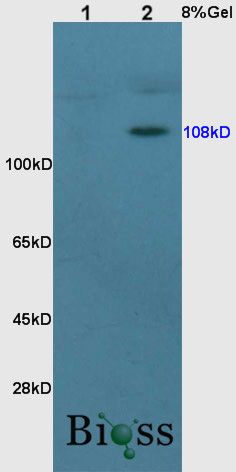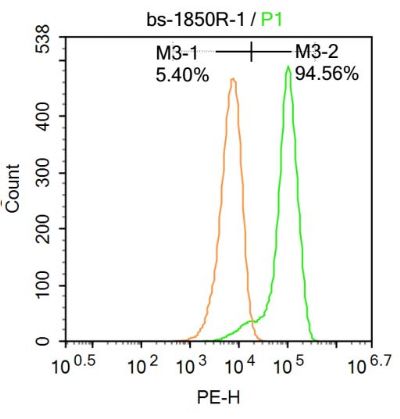产品中心
当前位置:首页>产品中心Anti-NR3C2/Mineralocorticoid receptor
货号: bs-1850R 基本售价: 780.0 元 规格: 50ul
- 规格:50ul
- 价格:780.00元
- 规格:100ul
- 价格:1380.00元
- 规格:200ul
- 价格:2200.00元
产品信息
- 产品编号
- bs-1850R
- 英文名称
- NR3C2/Mineralocorticoid receptor
- 中文名称
- 盐皮质激素受体抗体
- 别 名
- Aldosterone receptor; MCR; MGC133092; MLR; MR; NR3 C2; NR3C2; NR3C2 protein; Nuclear receptor subfamily 3 group C member 2; MCR_HUMAN.
- 规格价格
- 50ul/780元购买 100ul/1380元购买 200ul/2200元购买 大包装/询价
- 说 明 书
- 50ul 100ul 200ul
- 研究领域
- 细胞生物 免疫学 转录调节因子
- 抗体来源
- Rabbit
- 克隆类型
- Polyclonal
- 交叉反应
- Human, Mouse, Rat, Chicken, Dog, Pig, Cow, Rabbit,
- 产品应用
- ELISA=1:500-1000 IHC-P=1:400-800 IHC-F=1:400-800 Flow-Cyt=1ug/test IF=1:100-500 (石蜡切片需做抗原修复)
not yet tested in other applications.
optimal dilutions/concentrations should be determined by the end user.
- 分 子 量
- 107kDa
- 细胞定位
- 细胞核 细胞浆 细胞膜
- 性 状
- Lyophilized or Liquid
- 浓 度
- 1mg/ml
- 免 疫 原
- KLH conjugated synthetic peptide derived from human Mineralocorticoid receptor:601-700/984
- 亚 型
- IgG
- 纯化方法
- affinity purified by Protein A
- 储 存 液
- 0.01M TBS(pH7.4) with 1% BSA, 0.03% Proclin300 and 50% Glycerol.
- 保存条件
- Store at -20 °C for one year. Avoid repeated freeze/thaw cycles. The lyophilized antibody is stable at room temperature for at least one month and for greater than a year when kept at -20°C. When reconstituted in sterile pH 7.4 0.01M PBS or diluent of antibody the antibody is stable for at least two weeks at 2-4 °C.
- PubMed
- PubMed
- 产品介绍
- background:
Steroid receptors are ligand dependent, intracellular proteins that stimulate transcription of specific genes by binding to specific DNA sequences following activation by the appropriate hormone. Mineralocorticoids are a family of steroids, secreted by the adrenal cortex, necessary for the regulation of a number of metabolic processes including electrolyte regulation. These compounds exert their effect through their interaction with the mineralocorticoid receptor and that complexs subsequent association with DNA. Given the function of mineralocorticoids, it is not surprising to find that the kidney is a primary target organ for mineralocorticoids and that this organ has been shown to contain Mineralocorticoid Receptor.
Function:
Receptor for both mineralocorticoids (MC) such as aldosterone and glucocorticoids (GC) such as corticosterone or cortisol. Binds to mineralocorticoid response elements (MRE) and transactivates target genes. The effect of MC is to increase ion and water transport and thus raise extracellular fluid volume and blood pressure and lower potassium levels.
Subunit:
Heteromultimeric cytoplasmic complex with HSP90, HSP70, and FKBP4, in the absence of ligand. After ligand binding, it translocates to the nucleus and binds to DNA as a homodimer and as a heterodimer with NR3C1. May interact with HSD11B2 in the absence of ligand. Binds the coactivators NCOA1, NCOA2, TIF1 and NRIP1.
Subcellular Location:
Cytoplasm. Nucleus. Endoplasmic reticulum membrane; Peripheral membrane protein. Note=Cytoplasmic and nuclear in the absence of ligand; nuclear after ligand-binding. When bound to HSD11B2, it is found associated with the endoplasmic reticulum membrane.
Tissue Specificity:
Ubiquitous. Highly expressed in distal tubules, convoluted tubules and cortical collecting duct in kidney, and in sweat glands. Detected at lower levels in cardiomyocytes, in epidermis and in colon enterocytes.
Post-translational modifications:
Phosphorylated.
DISEASE:
Defects in NR3C2 are a cause of autosomal dominant pseudohypoaldosteronism type I (AD-PHA1) [MIM:177735]. PHA1 is characterized by urinary salt wasting, resulting from target organ unresponsiveness to mineralocorticoids. There are 2 forms of PHA1: the autosomal dominant form that is mild, and the recessive form which is more severe and due to defects in any of the epithelial sodium channel subunits. In AD-PHA1 the target organ defect is confined to kidney. Clinical expression can vary from asymptomatic to moderate. It may be severe at birth, but symptoms remit with age. Familial and sporadic cases have been reported.
Defects in NR3C2 are a cause of early-onset hypertension with severe exacerbation in pregnancy (EOHSEP) [MIM:605115]. Inheritance is autosomal dominant. The disease is characterized by the onset of severe hypertension before the age of 20, and by suppression of aldosterone secretion.
Similarity:
Belongs to the nuclear hormone receptor family. NR3 subfamily. Contains 1 nuclear receptor DNA-binding domain.
SWISS:
P08235
Gene ID:
4306
Database links:Entrez Gene: 4306 Human
Entrez Gene: 110784 Mouse
Entrez Gene: 25672 Rat
Omim: 600983 Human
SwissProt: P08235 Human
SwissProt: Q8VII8 Mouse
SwissProt: P22199 Rat
Unigene: 163924 Human
Unigene: 723668 Human
Unigene: 324393 Mouse
Unigene: 9678 Rat
Important Note:
This product as supplied is intended for research use only, not for use in human, therapeutic or diagnostic applications.
Mineralocorticoid receptor属于类固醇/甲状腺/维生素A配体依赖的转录因子受体超家族,是调节机体水盐代谢的重要甾体激素,有重要的生理、病理功能。
- 产品图片
 Sample:
Sample:
Lane1: Brain(Rat) Lysate at 30 ug
Lane2: Kidney(Rat)Lysate at 30 ug
Primary: Anti-MCR (bs-1850R) at 1:200 dilution;
Secondary: HRP conjugated Goat-Anti-Rabbit IgG(bse-0295G) at 1: 3000 dilution;
Predicted band size : 108kD
Observed band size : 108kD Paraformaldehyde-fixed, paraffin embedded (Mouse brain); Antigen retrieval by boiling in sodium citrate buffer (pH6.0) for 15min; Block endogenous peroxidase by 3% hydrogen peroxide for 20 minutes; Blocking buffer (normal goat serum) at 37°C for 30min; Antibody incubation with (NR3C2/Mineralocorticoid receptor) Polyclonal Antibody, Unconjugated (bs-1850R) at 1:400 overnight at 4°C, followed by operating according to SP Kit(Rabbit) (sp-0023) instructionsand DAB staining.
Paraformaldehyde-fixed, paraffin embedded (Mouse brain); Antigen retrieval by boiling in sodium citrate buffer (pH6.0) for 15min; Block endogenous peroxidase by 3% hydrogen peroxide for 20 minutes; Blocking buffer (normal goat serum) at 37°C for 30min; Antibody incubation with (NR3C2/Mineralocorticoid receptor) Polyclonal Antibody, Unconjugated (bs-1850R) at 1:400 overnight at 4°C, followed by operating according to SP Kit(Rabbit) (sp-0023) instructionsand DAB staining. Blank control:Molt-4.
Blank control:Molt-4.
Primary Antibody (green line): Rabbit Anti-RPS6KB1 antibody (bs-1850R)
Dilution: 1μg /10^6 cells;
Isotype Control Antibody (orange line): Rabbit IgG .
Secondary Antibody : Goat anti-rabbit IgG-AF647
Dilution: 1μg /test.
Protocol
The cells were fixed with 4% PFA (10min at room temperature)and then permeabilized with 90% ice-cold methanol for 20 min at-20℃. The cells were then incubated in 5%BSA to block non-specific protein-protein interactions for 30 min at at room temperature .Cells stained with Primary Antibody for 30 min at room temperature. The secondary antibody used for 40 min at room temperature. Acquisition of 20,000 events was performed.

